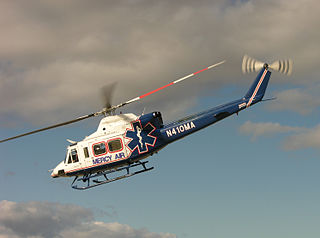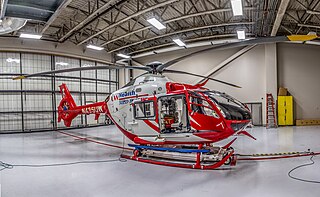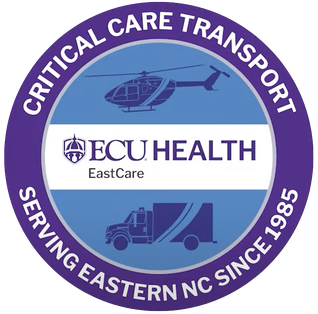
Valley Hospital Medical Center is a for-profit hospital owned by Universal Health Services and operated by Valley Health System. It is one of six hospitals within the Valley Health System in Las Vegas, Nevada. It is accredited by the Joint Commission and includes a certified Primary Stroke Center, an accredited Chest Pain Center and a certified Heart Failure Center.
ARCH Air Medical Service is an emergency medical service (EMS) that provides critical care air ambulance service in Missouri, Illinois, and the surrounding regions. Air ambulance programs offer transport by helicopter (rotor-wing) or fixed-wing aircraft. ARCH Air was the twelfth program in the U.S. to offer such services when it began operating in March 1979. Transporting approximately 4,200 patients per year by helicopter, ARCH aircraft are staffed by a pilot, nurse and paramedic. Flights are 80% inter-facility and 20% scene.

London's Air Ambulance Charity is a registered charity that operates a helicopter emergency medical service (HEMS) dedicated to responding to serious trauma emergencies in and around London. Using a helicopter from 08:00 to sunset and rapid response vehicles by night, the service performs advanced medical interventions at the scene of the incident in life-threatening, time-critical situations.
Memorial Hermann Life Flight is a hospital-based air medical transport service in Houston, Texas. Prior to 2020, Life Flight flew into 12th floor of the John S. Dunn Heli-Stop atop Memorial Hermann Hospital-Texas Medical Center. In March of 2020, Memorial Hermann-TMC opened the new 18 story Sarofim Pavilion, which serves as the home for Life Flight operations in addition to an expanded helipad atop the pavilion. Life Flight was founded in 1976.
Flight for Life is a prehospital care service with many bases of operation across the United States. Flight for Life is primarily known for its emergency medical helicopter transport, but also operates a fleet of land vehicles and fixed-wing aircraft for the transport of critically ill patients to specialized medical care. Helicopter transport is normally reserved for the most critically injured patients or patients who cannot be reached by traditional means of Emergency medical services. Helicopter transport is also especially useful for the transport of critically wounded patients to specialty medical facilities, such as burn, pediatric, or advanced trauma centers, that may be further away from the location of injury. Many rural communities rely on the speed of the helicopter to reach and evacuate their most serious patients to an available medical center. The helicopter may also be used for search and rescue operations in conjunction with ground units or alone.

The 2006 Mercy Air helicopter accident occurred on December 10, 2006, about 17:55 Pacific Standard Time, when a Bell 412SP helicopter, call sign "Mercy Air 2" impacted mountainous terrain near Hesperia, California and the Cajon Pass. The commercial helicopter pilot and two medical crew members were killed, and the helicopter was destroyed by impact forces and a postcrash fire.
Air Methods Corporation is an American privately owned helicopter operator. The air medical division provides emergency medical services to over 100,000 patients every year. It operates in 48 states with air medical as its primary business focus. Its corporate headquarters are located in the Denver Technological Center, Greenwood Village, Colorado, in the Denver metropolitan area.

The safety of emergency medical services flights has become a topic of public interest in the United States, with the expansion of emergency medical services aviation operations, such as air ambulance and MEDEVAC, and the increasing frequency of related accidents.

UW Health Med Flight is an air ambulance service based at University of Wisconsin Hospital in Madison, Wisconsin. Med Flight was established in 1985, and now operate 3 bases in Madison, Mineral Point and Portage.
Lifestar is an aeromedical transport service of the University of Tennessee Medical Center that provides regional rapid transportation of injured patients. Lifestar transports approximately 200 patients per month.

The Trauma Hawk Aero-Medical Program provides air ambulance services for Palm Beach County, Florida. On-scene paramedics will decide whether or not a Traumahawk is necessary in a situation. On average, a Traumahawk is dispatched between 1 and 5 times a day for traumatic injuries, including those from vehicle accidents to sports injuries, as well as transport for stroke and cardiac patients. Operated by the Health Care District of Palm Beach County, the service uses two identical 1999 Sikorsky S76-C+ helicopters as air ambulances.

The East Anglian Air Ambulance (EAAA) is an air ambulance providing Helicopter Emergency Medical Services (HEMS) across the English counties of Norfolk, Suffolk, Cambridgeshire and Bedfordshire. The appeal to fund the service was launched in the summer of 2000 by top jockey Frankie Dettori, who had been a casualty in a serious plane crash a couple of months earlier. When flying commenced in January 2001, the service was initially available only one day a week. The East Anglian Air Ambulance operates two helicopters, 365 days a year, from its bases at Cambridge Airport and Norwich Airport, covering over 5,000 square miles (13,000 km2) and a population of approximately 3.5 million.
Air ambulances in the United States are operated by a variety of hospitals, local government agencies, and for-profit companies. Medical evacuations by air are also performed by the United States Armed Forces and United States National Guard.
Air Evac EMS, Inc., operating as Air Evac Lifeteam and sometimes called simply Air Evac, is an American helicopter emergency medical service (HEMS) or air ambulance provider headquartered in O'Fallon, Missouri. It is the largest subsidiary of Global Medical Response, though still considered an independent provider. It is also the largest membership-supported air ambulance service in the US operating helicopters from 140 bases in 15 states, mostly in the central and southern regions of the country. While primarily a HEMS provider, it also operates 2 fixed-wing aircraft in Missouri and Kentucky.

ECU Health EastCare is the critical care mobile air and ground transport of ECU Health at ECU Health Medical Center. It serves 31 counties in Eastern North Carolina. It is sponsored by ECU Health Medical Center and The Brody School of Medicine at East Carolina University. ECU Medical Center is the only level 1 trauma center east of Raleigh. EastCare's five full-time air ambulances constitute the largest air medical program in North Carolina and can serve a radius of 230 nautical miles around Greenville without refueling.

Air medical services are the use of aircraft, including both fixed-wing aircraft and helicopters to provide various kinds of medical care, especially prehospital, emergency and critical care to patients during aeromedical evacuation and rescue operations.
Saskatchewan Air Ambulance is the air ambulance service for the province of Saskatchewan and for the Ministry of Health (Saskatchewan).
Life Flight Network is a non profit air and ground critical care transport service based in Aurora, Oregon, in the northern Willamette Valley, with services in Oregon, Washington, Idaho, and Montana in the United States.

Travis County STAR Flight is the emergency helicopter service of Travis County, Texas. As an agency of the Travis County government, STAR Flight conducts air ambulance, technical rescue, firefighting, and law enforcement support missions. Its area of operations includes 19 surrounding counties.

CareFlite is a nonprofit ambulance service based in Grand Prairie, Texas, which operates throughout North and Central Texas. CareFlite's original namesake service is helicopter air ambulance, though today it also performs fixed-wing and ground transport.











